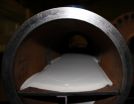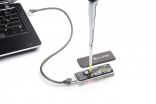(Press-News.org) Triple-negative breast cancer is as bad as it sounds. The cells that form these tumors lack three proteins that would make the cancer respond to powerful, customized treatments. Instead, doctors are left with treating these patients with traditional chemotherapy drugs that only show long-term effectiveness in 20 percent of women with triple-negative breast cancer. Now, researchers at The Johns Hopkins University have discovered a way that breast cancer cells are able to resist the effects of chemotherapy -- and they have found a way to reverse that process.
A report of their findings was published online in the journal Proceedings of the National Academy of Sciences on Dec. 1.
Triple-negative breast cancers account for about 20 percent of all breast cancers in the United States, and 30 percent of all breast cancers in African-American women. In addition to being resistant to chemotherapy, they are known to include a high number of breast cancer stem cells, which are responsible for relapses and for producing the metastatic tumors that lead to the death of patients with cancer. Previous research revealed that triple-negative breast cancer cells show a marked increase in the activity of many genes known to be controlled by the protein hypoxia-inducible factor (HIF). Given these past results, a research team directed by Gregg Semenza, M.D., Ph.D., decided to test whether HIF inhibitors could improve the effectiveness of chemotherapy.
"Our study showed that chemotherapy turns on HIF and that HIF enhances the survival of breast cancer stem cells, which are the cancer cells that must be killed to prevent relapse and metastasis," says Semenza, the C. Michael Armstrong Professor of Medicine at Johns Hopkins and a Johns Hopkins Kimmel Cancer Center expert. "The good news is that we have drugs that block HIF from acting."
Semenza's study began by treating lab-grown triple-negative breast cancer cells with the chemotherapy drug paclitaxel and looking for changes in HIF levels. After four days of treatment, HIF protein and activity levels had increased, as had the percentage of breast cancer stem cells among the surviving cells. When Semenza's team, led by postdoctoral fellow Debangshu Samanta, Ph.D., genetically altered the cancer cells to have less HIF, the cancer stem cells were no longer protected from death by chemotherapy, demonstrating that HIF was required for the cancer stem cells to resist the toxic effects of paclitaxel, Semenza says.
At the molecular level, the team found that one of the ways HIF enhances the survival of the stem cells is by increasing the levels of a protein, multidrug resistance protein 1 (MDR1), which acts like a pump to expel chemotherapy from cancer cells. However, when triple-negative breast cancer cells were given paclitaxel plus the HIF inhibitor digoxin, MDR1 levels went down rather than up.
In mice that were implanted with triple-negative breast cancer cells, treatment with digoxin and paclitaxel decreased tumor size by 30 percent more than treatment with paclitaxel alone. The combination therapy also decreased the number of breast cancer stem cells and the levels of MDR1. Treatment with digoxin plus a different chemotherapy drug, gemcitabine, brought tumor volumes to zero within three weeks and prevented the immediate relapse at the end of treatment that was seen in mice treated with gemcitabine alone.
Analysis of patient databases showed that among women with triple-negative breast cancer who are treated with chemotherapy, those with higher-than-average levels of HIF activity in their tumor were much more likely to die of breast cancer than those with lower-than-average HIF levels. Samanta notes that the HIF inhibitor digoxin is already approved by the Food and Drug Administration for treating heart failure. Several other drugs that inhibit HIF have also been identified and are currently being tested in patients with cancer. If the team's work is verified in clinical trials, the researchers think that potentially unresponsive patients could be identified before treatment and given a more effective combination therapy.
INFORMATION:
Fast Facts
Only 20 percent of patients with so-called triple-negative breast cancer respond fully to chemotherapy.
New research shows that chemotherapeutic drugs stimulate the HIF protein network in the cancer cells, enhancing their ability to survive.
Giving HIF inhibitors together with traditional chemotherapy decreased tumor size in mice.
Other authors of the report include Daniele Gilkes, Pallavi Chaturvedi and Lisha Xiang of the Johns Hopkins University School of Medicine.
This work was supported by grants from the Department of Defense (W81XWH-12-1-0464), the Maryland Department of Health and Mental Hygiene (FH-B33-CRF), the Cindy Rosencrans Fund for Triple Negative Breast Cancer, the WTFC Organization and the National Cancer Institute (K99-CA181352).
On the Web
View the article at PNAS. http://dx.doi.org/10.1073/pnas.1421438111
Learn more about Semenza: http://www.hopkinsmedicine.org/profiles/results/directory/profile/800056/gregg-semenza
Related stories: http://www.hopkinsmedicine.org/institute_cell_engineering/experts/meet_scientists/gregg_semenza.html
CLEVELAND: Researchers from Seidman Cancer Center at University Hospitals (UH) Case Medical Center and Case Western Reserve University School of Medicine presented new research findings this weekend at the 56th Annual Meeting of the American Society of Hematology (ASH) in San Francisco.
In a poster presentation (Abstract #4053), Jane Little, MD, and colleagues presented promising findings related to a novel biochip aimed at improving outcomes for patients with sickle cell disease. Although it is well-known that red cell interactions are important in sickle cell disease, ...
According to a new NOAA-sponsored study, natural oceanic and atmospheric patterns are the primary drivers behind California's ongoing drought. A high pressure ridge off the West Coast (typical of historic droughts) prevailed for three winters, blocking important wet season storms, with ocean surface temperature patterns making such a ridge much more likely. Typically, the winter season in California provides the state with a majority of its annual snow and rainfall that replenish water supplies for communities and ecosystems.
Further studies on these oceanic conditions ...
Using one of the most powerful lasers in the world, researchers have accelerated subatomic particles to the highest energies ever recorded from a compact accelerator.
The team, from the U.S. Department of Energy's Lawrence Berkeley National Lab (Berkeley Lab), used a specialized petawatt laser and a charged-particle gas called plasma to get the particles up to speed. The setup is known as a laser-plasma accelerator, an emerging class of particle accelerators that physicists believe can shrink traditional, miles-long accelerators to machines that can fit on a table.
The ...
If you want your child to tell the truth, it's best not to threaten to punish them if they lie. That's what researchers discovered through a simple experiment involving 372 children between the ages of 4 and 8.
How the Experiment was Done
The researchers, led by Prof. Victoria Talwar of McGill's Dept. of Educational and Counselling Psychology, left each child alone in a room for 1 minute with a toy behind them on a table, having told the child not to peek during their absence.
While they were out of the room, a hidden video camera filmed what went on.
When the ...
AMHERST, Mass. - New three-dimensional (3D) numerical modeling that captures far more geometric complexity of an active fault segment in southern California than any other, suggests that the overall earthquake hazard for towns on the west side of the Coachella Valley such as Palm Springs and Palm Desert may be slightly lower than previously believed.
New simulations of deformation on three alternative fault configurations for the Coachella Valley segment of the San Andreas Fault conducted by geoscientists Michele Cooke and Laura Fattaruso of the University of Massachusetts ...
Hamilton, ON (Dec. 8, 2014) - Researchers from McMaster University have identified an important hormone that is elevated in obese people and contributes to obesity and diabetes by inhibiting brown fat activity.
Brown adipose tissue, widely known as brown fat, is located around the collarbone and acts as the body's furnace to burn calories. It also keeps the body warm. Obese people have less of it, and its activity is decreased with age. Until now, researchers haven't understood why.
There are two types of serotonin. Most people are familiar with the first type in the ...
Recently, the researchers had constructed several single molecules with dual hormone action. Now, for the first time, the researchers succeeded in designing a substance that combines three metabolically active hormone components (GLP-1, GIP and glucagon) and offers unmatched potency to fight metabolic diseases in pre-clinical trials.
The team headed by physician scientist Matthias Tschöp (Helmholtz Diabetes Center at HMGU and Metabolic Diseases Chair at TUM) and peptide chemist Richard DiMarchi (Indiana University) has been cooperating for almost a decade to invent ...
Harvard Stem Cell Institute researchers at Harvard and Massachusetts General Hospital have taken what they are describing as "the first step toward a pill that can replace the treadmill" for the control of obesity - though it of course would not provide all the additional benefits of exercise.
Chad Cowan, an HSCI Principal Faculty Member and his HSCI team report that they have created a system using human stem cells to screen for compounds that have the potential to turn white, or 'bad', fat cells into brown, or 'good' fat cells, and have already identified two compounds ...
Titan, Saturn's largest moon, is a peculiar place. Unlike any other moon, it has a dense atmosphere. It has rivers and lakes made up of components of natural gas, such as ethane and methane. It also has windswept dunes that are hundreds of yards high, more than a mile wide and hundreds of miles long--despite data suggesting the body to have only light breezes.
Research led by Devon Burr, an associate professor in the Earth and Planetary Sciences Department at the University of Tennessee, Knoxville, shows that winds on Titan must blow faster than previously thought to ...
New nanopore DNA sequencing technology on a device the size of a USB stick could be used to diagnose infection - according to new research from the University of East Anglia and Public Health England.
Researchers tested the new technology with a complex problem - determining the cause of antibiotic resistance in a new multi-drug resistant strain of the bacterium that causes Typhoid.
The results, published today in the journal Nature Biotechnology, reveal that the small, accessible and cost effective technology could revolutionise genomic sequencing.
Current technology ...





